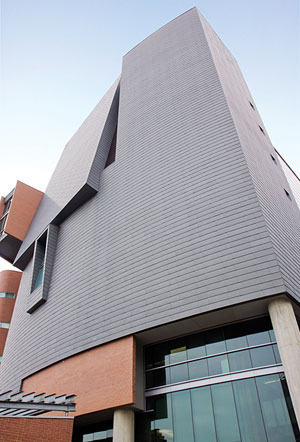Zinc: The Sustainable Choice among Architectural Metals
Learning Objectives:
- Differentiate among basic qualities of zinc as a building material compared to other architectural metals.
- Analyze and assess the multiple qualities of zinc that can contribute to green and sustainable building design.
- Examine the different applications of exterior zinc wall panel systems including green building applications.
- Explore the life cycle benefits of zinc roofing among common applications.
Credits:
Architectural metals are used widely in commercial, institutional, and industrial buildings. In order to meet the variety of design conditions in these different building types, architects in the US have often turned to some rather energy intensive metal choices such as aluminum, copper, painted steel, and stainless steel. However, the use of zinc as an architectural metal of choice is gaining popularity in this country and catching up with its widespread and long term use in other parts of the world. Parts of Asia and Europe in particular have used zinc as a building envelope material for generations. Americans are recognizing not only the historical long term durability of zinc but the recent growth in its use in the US is based in part on the recognition of the green and sustainability attributes that it can contribute to a building design.
Zinc Overview
In reviewing any building material, it is always appropriate to start with a basic understanding of key characteristics of that material which are summarized below for zinc:
• Natural prevalence: Zinc is a very natural and significant mineral that is prevalent throughout the world. In fact, it is reported to be the 23rd most abundant element in the earth's crust found not only in rocks, soil, air and water, but also in all living organisms including plants, animals, and humans. As a human nutrient, it contributes to normal growth processes and it has been shown that a lack of zinc in human diets is a significant cause of childhood disease and mortality, particularly in underdeveloped countries. Zinc is used in fertilizers to enrich agricultural soils and increase yields yet it is this very ability to mix and link with other elements in soils that keeps it at safe levels for human exposure.
 |
Photo: Gilbertson Photography |
• Available supply: Zinc is mined worldwide predominantly from extraction processes that avoid strip mining meaning that less land is disturbed and any potential environmental damage is minimized. Various projections have been made about the worldwide supply of zinc, but current estimates go up to 750 years worth of supply at current extraction levels. When re-cycling and re-use of zinc is considered, the projections are even longer.
• Processing: There appear to be fewer zinc processing plants than other types of metal processing plants around the world however, these zinc processing plants are reputed to meet current and projected demand. The environmental air emissions produced from zinc processing at these plants are minimized due to the use of up to date equipment and emission abatement processes during smelting. But quite significantly, zinc requires less energy to process due to its relatively lower melting point of 786°F (419°C) compared to other metals like aluminum at 1120°F (660°C), copper at 1983°F (1084°C), and steel at 2372°F (1300°C).
• Durability: Since zinc is a non-ferrous metal, it is not subject to the rust and corrosion found in iron, steel, and other ferrous materials. According to the International Zinc Association's "Zinc for Life" program, "Zinc material requires little maintenance over its service life; its (natural) patina constantly renews itself as it weathers and ages and will ‘heal over' scratches and imperfections, requiring no touch-up or repainting. Because the metal is uncoated, there is no possibility of the fading, chipping or peeling that otherwise needs recurrent attention. A single zinc roof, with a lifespan of 80 to 100 years may well outlast the building it has been sheltering." It should be noted that wall panels using zinc, without the environmental rigors of roofing applications, may have service lives of 200 to 300 years, depending on the product used and local conditions.
• Coloration or patina: The key to the extraordinary durability of zinc roofs and facades, and its beauty over time, is the ability of zinc metal to develop a natural protective patina. Again according to the International Zinc Association, "Just as copper ages from orange to green, zinc over time develops its distinctive patina, going from shiny silver to matte gray (depending on the precise alloy, other colors and finishes are also possible). In contact with the water, oxygen and carbon dioxide molecules in the atmosphere, the surface forms a closely adhering protective layer of zinc carbonate, which is insoluble in rainwater and will hinder any further exchanges between oxygen and zinc, thereby protecting the zinc from further corrosion. Zinc continues to renew this protective layer throughout its life, although the heaviest formation is usually complete in about five years, and will self-repair any imperfections or scratches." It should be noted, too, that some manufacturers of zinc products provide a complete "color management" system that allows for a "pre-patination" to occur giving greater control over the color of the installed product initially and over time. In addition, the patina process means that architectural zinc panels can be perforated with any number of patterns without worry about rust and usually at a dramatic cost savings compared to treated steel and other mesh and expanded options on the market.









